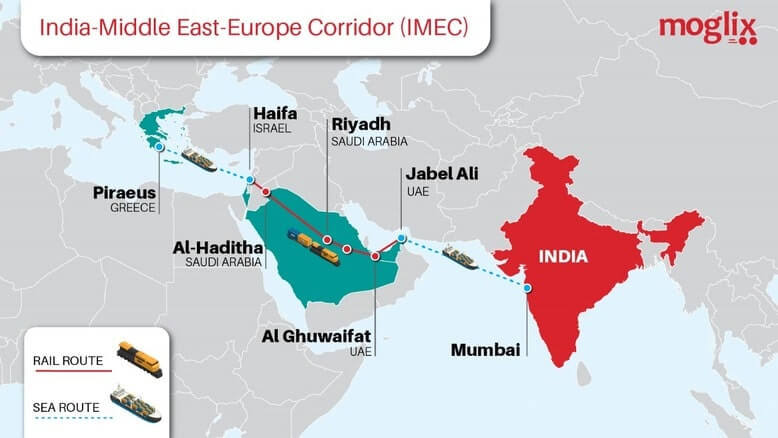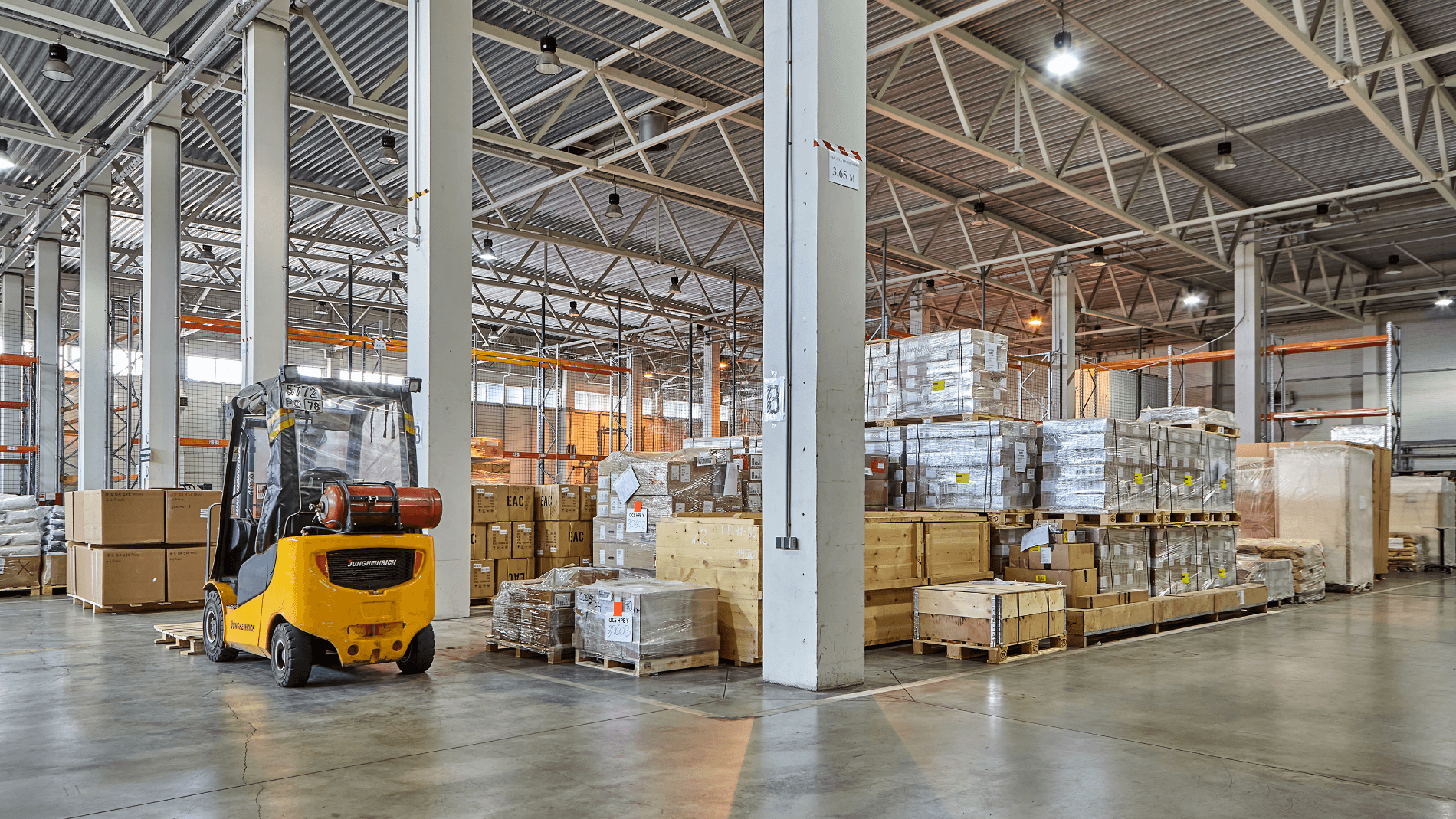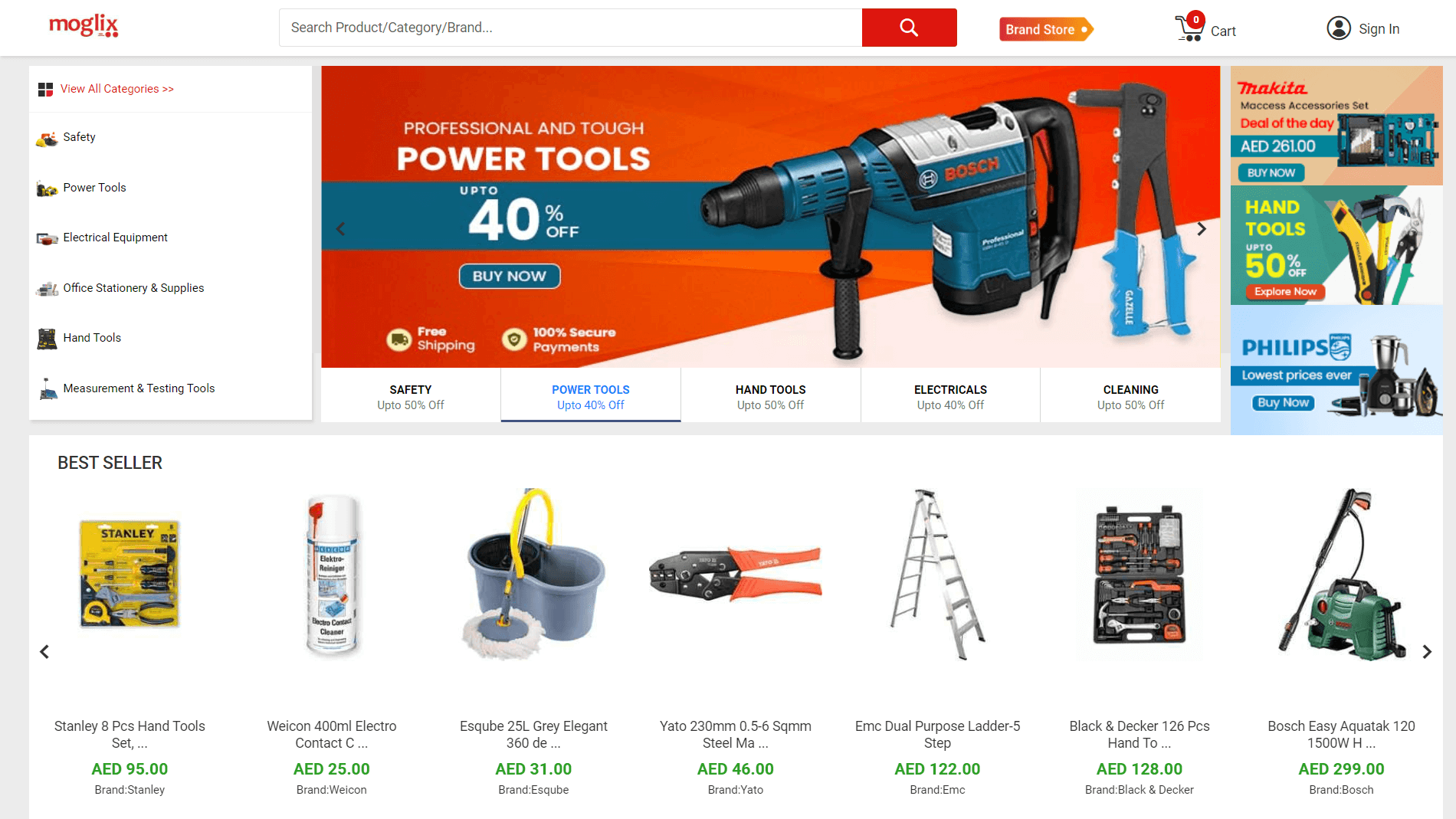COP 28: The Middle East’s Adaptive Reuse Phenomenon is Revolutionizing Sustainability

COP 28: The Middle East’s Adaptive Reuse Phenomenon is Revolutionizing Sustainability
The grandeur of the Middle East often overshadows the pressing need for sustainable practices in the region. As the world marches towards a greener future, the Middle East is now awakening to the potential of adaptive reuse, a trend that has been transforming underused buildings and sites worldwide. This concept is redefining the landscape of the Middle East and heralds a sustainable revolution in architecture and urban planning.
Adaptive Reuse: A Global Trend
Adaptive reuse, the process of reimagining older structures, is gaining momentum globally. It involves transforming underused buildings into more practical and functional spaces, ensuring that the architectural heritage is preserved while addressing modern urban needs. Cities like New York and London have been at the forefront of this trend, redefining their landscapes and preserving history simultaneously. New York’s One Wall Street, once an office building, has now found new life as a residential haven, and London’s No.1 Grosvenor Square is now a super-prime residential complex. Battersea Power Station, a decommissioned landmark, is currently undergoing transformation into a mixed-use development. These global success stories have set the stage for adaptive reuse to become a game-changing phenomenon.
Middle East is Adapting
In the Middle East, adaptive reuse is not a new concept. The UAE government has showcased the benefits of re-purposing old structures, with projects like the Bastakiya neighborhood and Al Serkal Avenue. The Bastakiya neighborhood now boasts cafes, art galleries, and boutique hotels, preserving its historical significance while fostering culture and community. Al Serkal Avenue, once an industrial zone, has become a hub for arts and culture, contributing to a vibrant arts community.
Expo City Dubai exemplifies the potential of adaptive reuse. The site, originally developed for World Expo 2020, has been entirely reimagined into a self-sustaining, 15-minute city. It prioritizes eco-friendliness, with green roofs and smart energy-saving appliances, setting a new standard for sustainable living. This transformation not only pays homage to the area’s past but also presents a promising future for the region
The Middle East is embracing sustainability as a core value. Re-purposing existing structures instead of constructing new ones significantly reduces carbon emissions, aligning with the United Nations Environment Program’s call to address the construction sector’s high carbon footprint. With the UAE’s construction market soaring, the need for sustainable solutions is evident.
‘Year of Sustainability
The UAE declared this year the ‘Year of Sustainability,’ aligning with COP28, emphasizing the importance of sustainable living. This move is expected to encourage regional developers to prioritize sustainability in their projects. As more people choose the Middle East as their home, the demand for housing and entertainment destinations will rise. Adaptive reuse projects offer an efficient and sustainable option to meet these needs. Buyers are increasingly drawn to high-quality adaptive reuse projects, and this trend is likely to continue. It’s an exciting era for sustainable development in the region.
Moglix in the UAE is working with real estate and construction companies to ensure their sustainability goals are aligned with their procurement goals. Moglix is the most comprehensive procurement solution in the UAE, that combines E catalog based buying experience, digital procurement and supply chain solution with a physical warehouse and logistics network, allowing you a complete and most comprehensive E2E procurement and supply chain solution. Reach Us
UAE and India: Crafting a High-Tech Future Together

UAE and India: Crafting a High-Tech Future Together
In a remarkable stride towards strengthening their economic and technological bonds, the United Arab Emirates (UAE) and India have unveiled a vision to bolster sustainable industrial development. This dynamic partnership sets the stage for mutual investments, technology transfers, and the adoption of cutting-edge innovations across various industries. The memorandum of understanding (MoU) was signed during the 11th meeting of the UAE-India High-Level Joint Task Force on Investments, showcasing a remarkable leap forward in their collaborative journey.
So, what’s in the pipeline? Let’s dive into this exciting alliance, where two nations join hands in a harmonious rhythm of growth and development.
Economic Partnership for the Ages
The MoU aligns seamlessly with the UAE-India Comprehensive Economic Partnership Agreement (CEPA). This strategic pact is a game-changer, designed to elevate trade and logistics ties between these two vibrant nations. The recent signing ceremony, presided over by Dr. Sultan Al Jaber, UAE Minister of Industry and Advanced Technology, and Piyush Goyal, India’s Minister of Commerce and Industry, marked a milestone in the strengthening of bilateral relations.
The Magnificent Seven: Key Areas of Collaboration
The collaborative efforts under the MoU are set to shape the future in seven key areas. Let’s take a sneak peek into what’s on the horizon:
1. Supply Chain Synergy
The UAE and India will join hands to identify opportunities for the supply of raw materials.
They’ll be sharing best practices for industrial growth, making sure this cooperation thrives in various domains, from energy to land, and technology to labor incentives.
2. Energizing the Future
Energy storage technologies, Smart Grid deployment, and IoT applications will be the focus.
Extensive research and development (R&D) in renewable energy and energy efficiency will lead to sustainable advancements.
3. Health & Life Sciences
Collaborating in the development of pharmaceuticals and unleashing the power of biotechnology.
Expect groundbreaking R&D to create innovations that’ll redefine healthcare.
4. Beyond the Stars
A combined mission to elevate their space industries, including the development, launch, and utilization of small satellites.
They’re even exploring space exploration and licensing of space-related materials – sounds like a journey to the cosmos!
5. AI-Powered Progress
With AI at the helm, the UAE and India are set to elevate multiple sectors, from space and energy to healthcare and supply chains.Advanced machine learning and data analytics are also on the roadmap for these forward-thinking nations.
6. The Revolution of Industry 4.0
Get ready for real-time data processing, autonomous robotics, and additive manufacturing across industries.These are the building blocks of the Fourth Industrial Revolution (4IR), shaping the industries of tomorrow.
7. Standardization and Beyond
Here, the focus is on standardization, metrology, conformity assessment, accreditation, and Halal certification.Their aim? To harmonize standards with international requirements and foster mutual recognition of conformity assessment results.
A Vision of Sustainable Growth
Dr. Sultan Al Jaber emphasizes that this MoU perfectly aligns with the UAE’s national industrial strategy and the “Make it in the Emirates” initiative. This ambitious venture seeks to transform the UAE into a global hub for advanced industries, especially those destined for the future.
Piyush Goyal, India’s Minister of Commerce and Industry, highlights the potential of the MoU to unlock new dimensions in emerging technologies. From space exploration to healthcare, renewable energy, artificial intelligence, and more, this collaboration is poised to break new ground.
As per the MoU, the UAE and India will join forces in industrial and academic collaborations, collaborative research and development projects, and best practice sharing. This partnership is more than just an agreement; it’s a catalyst for economic growth, diversification, and sustainability across key industries.
In this era of limitless possibilities, the UAE and India are crafting a high-tech future together. It’s not just an alliance; it’s a glimpse into the limitless potential of shared dreams and endeavors.As these nations bridge the divide, the rest of the world watches with bated breath, eager to see the remarkable transformation they’ll bring to life. After all, the future has never looked more promising.
The India-Middle East-Europe Economic Corridor – All you should know about

The India-Middle East-Europe Economic Corridor – All you should know about
In a significant development during the recently concluded G20 summit held in New Delhi, India, a groundbreaking initiative was unveiled, with far-reaching implications for geopolitics and global connectivity. The United States, India, Saudi Arabia, the United Arab Emirates, along with France, Germany, Italy, and the European Union, jointly introduced the India-Middle East-Europe Corridor (IMEC). This ambitious project aims to foster economic development by enhancing connectivity and integration between Asia, the Arabian Gulf, and Europe. While it carries profound implications for global trade and politics, the IMEC also represents a dynamic shift in regional alliances and aspirations.
The IMEC at a Glance
The India-Middle East-Europe Corridor is a multimode transit corridor spanning over 3,000 miles, consisting of two primary corridors. The eastern corridor connects India to the Arabian Gulf, while the northern corridor links the Arabian Gulf to Europe. This extensive project, as outlined in the White House’s memorandum of understanding, will establish a reliable and cost-effective cross-border ship-to-rail transit network. It is designed to complement existing maritime and road transport routes, facilitating the seamless movement of goods and services between India, the UAE, Saudi Arabia, Jordan, Israel, and Europe. It is not limited to rail and shipping routes; rather, it includes an electricity cable, a hydrogen pipeline, and a high-speed data cable. This diverse range of infrastructure projects is poised to enhance trade and energy flows among the participating countries.
A Counter to China’s Belt and Road Initiative
China’s Belt and Road Initiative (BRI) has been a prominent player in global infrastructure development over the past decade. However, recent data suggests a stagnation in the value of new foreign contracted projects under the BRI since its peak in 2019, coinciding with China’s domestic real estate debt crisis. This economic challenge has raised questions about the sustainability of China’s expansive infrastructure program.
One of the most noteworthy aspects of the IMEC’s unveiling was the swift positioning of the corridor as an alternative to China’s Belt and Road Initiative (BRI). The BRI has significantly expanded China’s influence by developing trade and infrastructure networks across Asia, Europe, and Africa. However, the IMEC is not simply a rival to the BRI; it represents a different approach to regional cooperation.
Saudi Arabia and the UAE, central players in the IMEC, have shown reluctance to engage in a bipolar world order that forces them to choose between China and the United States. Their active participation in both the IMEC and their recent admission to the BRICS group of major emerging economies underscores their commitment to maintaining autonomy and safeguarding their sovereignty.
Deepening Integration and Economic Convergence
The IMEC underscores the deepening integration between India, Saudi Arabia, and the UAE, signifying broader geopolitical and economic convergence between the Middle East and South Asia into West Asia. India has become Saudi Arabia’s second-largest trading partner, with bilateral trade reaching $52.75 billion during 2022-23, elevating Saudi Arabia to India’s fourth-largest trading partner. Similarly, trade between India and the UAE surged to $85 billion in 2022, positioning the UAE as India’s third-largest trading partner for the year 2022-23 and its second-largest export destination.
This shift in regional dynamics also reflects the evolving state of Pakistan-Gulf relations, where Saudi Arabia and the UAE have adjusted their economic and geopolitical posture toward India. This shift acknowledges India’s rising influence and signifies the aspirations of Gulf nations in the emerging multipolar world. In this changing landscape, traditional alliances are being reevaluated to align with geopolitical realities and economic opportunities.
Beyond Energy: Diversification and Autonomy
The IMEC signifies that Gulf states, particularly Saudi Arabia and the UAE, are actively seeking diverse economic and technological partnerships beyond their role as energy producers. While energy remains a core pillar of their economies, the IMEC highlights that they are determined to establish more diversified and resilient economies.
For years, Washington has primarily approached Gulf states with an energy-centric perspective. However, the IMEC signals a shift towards recognizing that bilateral relations with Saudi Arabia and the UAE are multidimensional. Energy is a significant component, but it is not the sole focus. The United States aims to change the trajectory in the Gulf by involving India in both geopolitical and economic aspects.
Way forward
The India-Middle East-Europe Economic Corridor is not merely an infrastructure project; it is a geopolitical game-changer. It signifies the evolving landscape of alliances, the quest for autonomy, and the recognition that the Gulf states are integral players in the global economy. As the project unfolds, it has the potential to reshape the future of connectivity, trade, and geopolitical influence in the Middle East, Asia, and Europe. The IMEC is a declaration that global partnerships can transcend traditional boundaries and create a more interconnected and prosperous world.
Will Data-Drive The UAE’s Path to Global Prominence?

Will Data-Drive The UAE’s Path to Global Prominence?
In the current business landscape, data has become the heartbeat of decision-making, reshaping industries and economies worldwide. To thrive in this era, companies must adopt data-driven strategies that permeate their organizational fabric, from top-level executives to every corner of the hierarchy. The UAE government’s strategic initiatives, underscored by digital transformation and artificial intelligence (AI) integration, have set the stage for a data-driven future. Amidst the changing dynamics spurred by the COVID-19 pandemic, digitalization has become not just an option but a necessity for survival and success.
PioneeringData-Driven Transformation
The COVID-19 pandemic didn’t just shake up the world; it propelled industries into a fast-paced digital transformation. In a telling Dell survey, a whopping 80% of global organizations revealed they ramped up their digital efforts in 2020, all thanks to the pandemic pushing them into gear. No longer a fancy add-on, going digital turned into a must-do for businesses to survive.
But let’s not think of this as just plugging in new tech tools. It’s a big shift in how businesses work. And that’s where the UAE comes in with its bold moves. They’ve taken giant leaps towards turning data into a decision-making superstar. Think about their Digital Government Strategy, their ambitious UAE Centennial 2071 plan, and the smart UAE Strategy for Artificial Intelligence. They’re not just plans; they’re a promise to embrace data like never before. And they’ve got the rulebook sorted with regulatory authorities making sure everything’s on track.
What’s really cool is how they’ve made data part of everyday business life. They’ve thrown open the doors to data, making it work in the background, helping them make smart decisions at every level. This isn’t just about making things look good; it’s about making things work better. They’re using data to make public services sharper, to deal with risks smarter, and to keep ahead in the global competition. The UAE is proving that in this world of new ideas powered by data, following the rules and planning things out isn’t just a plus – it’s what makes digital change really stick.
AI’s Indispensable Connection to Data Sanity
The UAE’s strategic investments in AI are poised to reap substantial rewards, with the country’s AI market projected to hit $1.9 billion by 2026, sporting a CAGR of 36.2%. This growth isn’t confined to the UAE alone; the Middle East’s AI market is on track to surge from $500 million in 2020 to an impressive $8.4 billion by 2026. E-commerce, fintech, and edtech are among the sectors at the forefront of this expansion, buoyed by a solid foundation of infrastructure, robust cybersecurity measures, and a tech-savvy populace.
However, while AI offers immense potential, its effectiveness is inextricably tied to data sanity – the precision, dependability, and pertinence of data. The crux lies in the quality of data that AI algorithms learn from, as these patterns dictate AI’s performance. Real-world instances underscore the perils of compromised data quality, leading to AI mishaps encompassing flawed predictions, subpar decisions, and operational hiccups. It’s a stark reminder that in the realm of AI, data quality is the linchpin upon which success hinges.
The UAE’s commitment to data-driven strategies sets a compelling example for global players. Embracing data-driven transformation isn’t merely a choice; it’s a necessity for survival and triumph. The journey to prominence lies in the hands of those who harness the power of data, ensuring they remain at the forefront of a rapidly evolving business landscape.
India-UAE a Journey Towards De-Dollarization

India-UAE a Journey Towards De-Dollarization
In a world where the U.S. dollar has long reigned as the dominant global currency, the concept of de-dollarization is gaining traction. De-dollarization refers to the process of reducing dependence on the U.S. dollar in international trade, financial transactions, and economic interactions. As economies seek to enhance their financial sovereignty and minimize exposure to external economic fluctuations, two nations stand out as pioneers in this journey: India and the United Arab Emirates (UAE). During Prime Minister Narendra Modi’s recent visit to the UAE, the Reserve Bank of India (RBI) and the Central Bank of the UAE inked two memoranda of understanding (MoUs). These agreements not only herald a new era of trade collaboration but also mark a significant stride toward the de-dollarization of trade relations. Let’s explore how this landmark initiative is set to reshape economic dynamics and pave the way for a more diversified financial landscape.
Local Currencies: A Catalyst for De-Dollarization:
At its core, this initiative introduces a Local Currency Settlement System (LCSS) that’s redefining cross-border transactions. The Local Currency Settlement System (LCSS) simplifies trade by enabling businesses and individuals in both India and the UAE to directly engage in transactions using their own currencies. This approach minimizes external currency dependence and streamlines the trading process.
This shift offers practical advantages. It allows businesses to manage foreign exchange risks more efficiently by avoiding third-party currency conversions. With contracts and invoices in local currencies, businesses can more confidently navigate price fluctuations and engage in fair trade practices.
The move towards local currencies reflects a changing economic landscape, signaling an intention to reshape financial dynamics. While the U.S. dollar remains important, the adoption of local currencies for cross-border transactions is a practical step towards trade autonomy. This shift not only boosts bilateral trade but also encourages investment and economic growth for both countries.
In essence, the LCSS represents a pragmatic approach towards economic autonomy. It’s about facilitating smoother cross-border interactions and nurturing trade relationships using familiar currencies. While the U.S. dollar’s role persists, the LCSS introduces a more diversified and balanced trade framework between India and the UAE
Mitigating ExchangeRate Risks and Fostering Competition
At the heart of this progressive initiative lies a concerted effort to address one of the most pressing hurdles in international trade – the unpredictability of exchange rate fluctuations. Conventionally, trade transactions have been orchestrated using third currencies as benchmarks, inadvertently exposing businesses to the uncertainty of currency valuation. This practice has often complicated pricing strategies and introduced an element of instability into trade dynamics.
By advocating for the adoption of local currencies in export contracts and invoices, this initiative introduces a transformative shift. It is a shift that not only redefines how trade is conducted but also offers a practical solution to the intricate web of exchange rate risks. The move to denominate contracts in local currencies provides a much-needed safeguard against the capricious nature of currency markets. This, in turn, creates an environment that is not only conducive to fostering competitive pricing but also empowers businesses with a newfound level of financial security.
This transition is far more than a mere economic maneuver. It’s a deliberate step towards asserting financial sovereignty – a demonstration of a nation’s ability to insulate its trade from external fluctuations. It signifies a collective determination to minimize vulnerability to the whims of global currency markets. As industries and businesses increasingly embrace this approach, the broader narrative unfolds as one of self-reliance, resilience, and an unwavering commitment to navigating the intricate complexities of global trade on one’s own terms.
Elevating Economic Ties
The partnership between India and the UAE has transcended borders and expectations, giving rise to an exceptional trade synergy that surpassed even the most optimistic projections. As we delve into the realms of economic ties, it’s evident that the India-UAE trade collaboration has not merely flourished; it has evolved into a resounding success story. The trade volume between these two nations, standing at an impressive $85 billion in 2022, serves as a testament to the strength and depth of this association.
Beyond the sheer numerical significance, this collaboration bears profound implications for both economies. The metamorphosis of the UAE into India’s second-largest trading partner underscores the pivotal role it plays in the Indian trade narrative. Simultaneously, India’s ascent to becoming the UAE’s third-largest trading partner and second-largest export destination reflects the reciprocal nature of this partnership, where mutual growth and benefits have been seamlessly intertwined.
Delving deeper, the robust foundation of this economic alliance is fortified by India’s influential position as the UAE’s fourth-largest investor. This underscores a shared vision of cultivating economic diversity and resilience. As India invests in the UAE, it not only signifies a financial commitment but also echoes a vote of confidence in the UAE’s potential as a strategic economic partner.
The confluence of trade, investment, and collaboration serves as a beacon illuminating a path towards a multifaceted economic ecosystem. The transformation of trade figures into tangible opportunities for businesses, entrepreneurs, and industries resonates with the core essence of this partnership. It’s a synergy that transcends numbers, encapsulating the shared aspirations of both nations to propel their economies to new horizons.
In essence, the India-UAE economic alliance is not merely about transactions; it embodies the essence of cooperation, growth, and progress. It stands as a living testament to the belief that partnerships built on trust, shared values, and complementary strengths can transcend expectations, elevate bilateral relations, and reshape the future economic landscape.
Seamless Transactions and Reduced Reliance on the Dollar
The second Memorandum of Understanding (MoU) stands as a testament to this endeavor, marking a pivotal stride in the de-dollarization effort. By ingeniously linking India’s Unified Payments Interface (UPI) with the UAE’s Instant Payment Platform (IPP), this initiative unfolds a realm of possibilities. It’s a strategic move that defies the traditional norms of global financial transactions and charts a new course driven by innovation and collaboration.
A cornerstone of this integration is the coupling of card switches—RuPay switch and UAESWITCH—a convergence that shatters barriers and paves the way for cross-border fund transfers of unparalleled efficiency. This union of payment systems heralds a new era of fast, secure, and cost-effective transactions, a realm where geographic boundaries hold no sway over the movement of funds. As two powerful systems unite, they create an intricate yet seamless web of financial connectivity, enabling individuals and businesses to navigate the intricate world of cross-border payments with unparalleled ease.
While this innovation bears far-reaching significance, its impact is particularly pronounced for the 3.5 million resident Indians in the UAE. Remittance costs, which have long weighed heavily on the minds of expatriates, are now poised to undergo a transformation. The alliance of UPI and IPP presents a viable solution, addressing a pressing concern by ushering in an era of reduced transaction costs. This move is more than a mere convenience; it’s a tangible relief for the millions who diligently contribute to their home country’s economy while supporting their families from afar.
In essence, the integration of UPI and IPP is more than a technical accomplishment; it’s a testament to the commitment of both nations to facilitate smoother financial interactions and bridge the gap between geographic distances and financial complexities. As these systems converge and resonate, they paint a portrait of a future where economic interactions are not bound by the constraints of the past but propelled by the possibilities of innovation. It’s a journey that encapsulates the essence of partnership, as two nations come together to rewrite the script of international financial transactions and set new standards of efficiency, inclusivity, and progress.
As India and the UAE embark on this transformative journey of trade diversification and reduced dollar reliance, they illuminate the path for others to follow. The de-dollarization momentum they’ve set in motion resonates far beyond their borders. This initiative signifies more than just financial innovation; it’s a declaration of economic resilience, strategic collaboration, and the pursuit of a future where financial sovereignty takes center stage. Through the India-UAE MOU, the stage is set for an epochal shift in trade dynamics, echoing a call for more balanced and diversified financial interactions on the global stage.
Transforming UAE’s Supply Chains for Sustainability and Transparency!

Transforming UAE’s Supply Chains for Sustainability and Transparency!
The UAE, like many other geographies, faces challenges in ensuring traceability and accountability in supply chains. Complex global networks, limited visibility, and reliance on manual processes hinder accurate data capture and verification. Recently though, the focus on sustainable practices and transparency in supply chains has gained significant momentum. Consumers and businesses in the UAE are increasingly conscious and concerned of the origin and environmental impact of products. To address these concerns and foster a greener economy, the UAE is increasingly focusing on blockchain as a technology to revolutionize traceability and accountability in its supply chains. Blockchain has the potential to play a pivotal role in driving sustainability and enhancing trust in the UAE’s supply chain ecosystem.
The energy sector stands is a prime example of an industry where blockchain can exert significant influence. With the potential for energy plants to cause irreparable harm, this highly regulated sector operates under intricate global and regional procedures, all while striving for sustainability. Global blockchain in energy market is projected to reach $1,564M by 2026 with a CAGR of 37.6%, as per Fortune Business Insights. The growing adoption of blockchain technology in the energy sector addresses regulatory compliance, sustainability, and process efficiency. This market growth signifies the transformative potential of blockchain in revolutionizing the energy industry for a sustainable future. By integrating blockchain technology, the energy sector effectively addresses these challenges, accelerating industry processes while ensuring compliance and environmental responsibility.
These changes are not just visible and confined to an industry. The UAE has witnessed remarkable implementations of blockchain-enabled traceability. For example, the Dubai Blockchain Food Safety Project leverages blockchain to enhance food safety by ensuring end-to-end traceability of food products. Similarly, the Emirates Authority for Standardization and Metrology (ESMA) collaborates with blockchain companies to authenticate halal products, fostering transparency and meeting Islamic dietary requirements.
Benefits of Blockchain-Enabled Traceability
The application of blockchain in supply chain management offers numerous advantages, including increased transparency, improved efficiency, enhanced traceability, and strengthened customer relationships. It also contributes to a better brand image and higher return on investment for businesses.
- Real-time tracking: Blockchain enables transparency and decentralization, allowing real-time tracking of activities in the supply chain, leading to increased transparency in industries like manufacturing and fashion.
- Faster processing: By replacing intermediaries and eliminating paper-based processes with smart contracts, blockchain reduces operational time and improves efficiency, especially in lower supply tiers and the shipping industry.
- Strengthening traceability: Blockchain technology enhances traceability in the supply chain, addressing demands and regulations for provenance information. It mitigates quality-related issues, such as reputational damage, recalls, and revenue loss due to counterfeit or unauthorized products.
- Healthy customer relationships: Blockchain empowers consumers to access detailed product information and track orders transparently, fostering trust and improving customer experience.
- Higher ROI: Blockchain helps businesses build a strong brand image in the decentralized market, leading to increased return on investment.
- Effective tradeability: Blockchain facilitates efficient licensing and ownership by utilizing smart contracts and maintaining consensus, ensuring accurate tracking of ownership records.
Overcoming Challenges and Adoption Considerations
While blockchain offers immense potential, challenges such as scalability and interoperability need to be addressed for widespread adoption in the UAE. Collaborative efforts among industry stakeholders, government support, and the development of regulatory frameworks are pivotal in overcoming these obstacles. The UAE Government issued Cabinet Resolution No.111 of 2022, which became effective on January 14, 2023. This resolution aims to regulate virtual asset-related activities by providing guidelines for entities engaged in such activities. The purpose is to ensure that these entities obtain the necessary licensing and approvals from Financial Regulators or their delegates. The UAE government has been pushing the envelope on blockchain and digital assests from last decade. The Emirates Blockchain Strategy was introduced by the UAE government in April 2018. Its objective is to leverage blockchain technology in order to migrate 50% of government transactions onto the blockchain platform by 2021. The strategy encompasses various initiatives that target improved efficiency, cost reduction, and enhanced customer experience.
Future Outlook
The future of sustainable supply chains in the UAE is intertwined with blockchain technology. As the UAE continues to prioritize environmental sustainability, blockchain’s integration with emerging technologies like the Internet of Things (IoT) and artificial intelligence (AI) will further enhance supply chain transparency and efficiency. For technologies to cross hands data will have to play a crucial role since AI relies heavily on data, hence data sanity will be of utmost importance. Moglix has been working with organisations in the UAE to sort their data challenges and transform their procurement value chain at a rapid yet sustainable pace
Embracing blockchain enables the UAE to solidify its position as a global leader in sustainable practices and reinforces its commitment to a greener future. The UAE’s commitment to revolutionizing supply chain traceability and accountability through blockchain technology demonstrates its dedication to sustainability and transparency. By leveraging blockchain, the UAE is building a robust and trustworthy supply chain ecosystem that aligns with consumer expectations, protects the environment, and drives the nation’s sustainable development goals.
Identifying and Eliminating Waste in Warehouse Operations

Identifying and Eliminating Waste in Warehouse Operations
Efficiency and cost savings are critical goals for any warehouse operation. To achieve these objectives, it is essential to identify and eliminate waste within warehouse processes. According to a study by the Warehousing Education and Research Council (WERC), transportation waste accounts for an average of 30% of total logistics costs in warehousing operations. Waste can manifest in various forms, hindering productivity, increasing costs, and impacting customer satisfaction. In this blog post, we will explore different types of waste commonly found in warehouse operations, discuss their impact, and share relevant statistics to emphasize the importance of waste elimination. By understanding and addressing these waste types, businesses can enhance operational efficiency, reduce costs, and optimize their warehouse operations. The Institute of Industrial Engineers (IIE) states that reducing waste in warehouse operations can lead to cost savings of up to 20% and productivity improvements of 10-30%.
Types of Waste in Warehouse Operations:
Transport Waste
Transportation waste refers to inefficiencies in the movement of goods within the warehouse. An example of this could include unnecessary material handling, inefficient routing, and excessive travel distances. These waste factors can result in increased fuel consumption, higher transportation costs, and delays in order fulfillment.
To eliminate transportation waste, warehouse managers can implement strategies such as optimizing delivery routes, consolidating shipments, and utilizing software solutions for route planning and tracking. By doing so, businesses can reduce fuel consumption, transportation costs, and improve overall delivery efficiency.
Inventory Waste
Inventory waste arises from poor inventory management practices. Overstocking, underutilization of available space, and the presence of obsolete inventory can tie up capital, lead to storage inefficiencies, and increase the risk of product expiration or obsolescence.
To address inventory waste, warehouse managers can focus on implementing just-in-time inventory management techniques, conducting regular inventory audits, and utilizing data-driven forecasting models. These strategies help optimize inventory levels, reduce carrying costs, and improve space utilization within the warehouse.
Motion Waste
Motion waste encompasses unnecessary or excessive movements within the warehouse. N example of this can include inefficient picking routes, disorganized storage layouts, and excessive searching for items. Motion waste contributes to increased labor costs, reduced productivity, and longer lead times. The Lean Enterprise Institute found that motion waste can contribute to up to 50% of total labor time in some warehouses, indicating significant room for improvement.
To eliminate motion waste, warehouse managers can optimize the layout of the warehouse, streamline picking paths, and implement efficient storage systems. Leveraging technology solutions like barcode scanning and automated guided vehicles (AGVs) can further enhance efficiency by minimizing unnecessary motion and improving overall productivity.
Waiting Waste
Waiting waste occurs when there are delays or bottlenecks in warehouse processes. It can be caused by factors such as lack of coordination between departments, machine breakdowns, or inadequate staffing. Waiting waste leads to idle time, decreased throughput, and customer dissatisfaction due to delayed order fulfillment.
To address waiting waste, warehouse managers should focus on improving communication and coordination between teams, ensuring machinery is well-maintained and properly serviced, and
optimizing staffing levels based on demand. By minimizing waiting times, warehouses can enhance overall productivity and improve customer satisfaction.
Overprocessing Waste
Overprocessing waste arises from unnecessary or excessive steps in warehouse operations. This can include redundant paperwork, double-checking processes, or additional inspections beyond what is required. Overprocessing waste adds complexity to operations, increases costs, and hampers overall efficiency.
To eliminate overprocessing waste, warehouse managers should review and streamline existing processes, automate repetitive tasks where possible, and ensure that quality checks are performed at appropriate stages. By eliminating unnecessary steps and optimizing processes, warehouses can reduce costs, improve operational efficiency, and accelerate order fulfillment.
Defects and Rework Waste
Defects and rework waste result from errors or substandard quality in warehouse operations. This includes damaged goods, incorrect labeling, picking errors, or inadequate packaging. Defects and rework waste lead to customer dissatisfaction, increased costs, and loss of productivity. The National Association of Manufacturers (NAM) reported that defects and rework waste can account for up to 20% of overall production costs in warehouses
To address defects and rework waste, warehouse managers should focus on implementing quality control measures, providing adequate training to warehouse staff, and utilizing technology solutions such as automated picking systems or quality assurance software. By improving accuracy and minimizing errors, warehouses can reduce rework, enhance customer satisfaction, and increase operational efficiency.
Every warehouse is unique, and identifying specific areas of waste requires a thorough analysis of your own operations. Tailor the waste elimination strategies to suit your warehouse’s specific needs and continually strive for continuous improvement to maximize efficiency and achieve long-term success. To successfully eliminate waste, warehouse managers should adopt a systematic approach that includes analyzing current processes, identifying areas of waste, implementing appropriate strategies, leveraging technology solutions, and continuously monitoring and improving operations. By embracing lean principles and utilizing data-driven insights, businesses can create leaner and more efficient warehouse operations, resulting in cost savings, improved customer experiences, and a competitive edge in the market. Moglix’s evolving warehouse network in UAE is providing reliable inventory management solutions to its customers. With strategically located warehouses in the UAE, Moglix ensures quick and efficient delivery, reducing lead time and optimizing supply chain management. Know More
Moglix substantially reduces procurement lead time by 60 days for one of largest steel & building materials manufacturer in the UAE

Moglix substantially reduces procurement lead time by 60 days for one of largest steel & building materials manufacturer in the UAE
Moglix Enables Supply Chain Predictability and Efficiency for a COVID19 Vaccine Manufacturerقراءة المزيد
Challenges faced by e-commerce

Challenges faced by e-commerce
E-commerce is growing at an unprecedented pace in the UAE, as more consumers are turning to online shopping due to its convenience, speed, and safety during the COVID-19 pandemic. According to a recent report by Dubai Economy, the e-commerce market in the UAE grew by 47 per cent in 2020, with online sales reaching AED 24.8 billion ($6.8 billion). Furthermore, the same report predicts that the UAE’s e-commerce market reached AED 100 billion ($27 billion) by 2022, representing a remarkable growth opportunity for businesses operating in the supply chain and procurement sectors. However, with the rapid expansion of e-commerce comes a number of challenges that businesses must overcome to capitalise on this growth trend.
Meeting customer expectations
The rise of e-commerce has changed customer expectations, with many consumers now expecting faster delivery times and more flexible shipping options. For businesses in the UAE’s supply chain and procurement industries, this means adapting to new delivery models and investing in technologies like real-time tracking and automated warehousing.
Managing Inventory
In the UAE, successful inventory management is essential for e-commerce companies. Businesses must make sure they have adequate inventory on hand to meet demand without overstocking, given the rapid growth of internet sales. Understanding procurement holistically and choosing partners who can provide Procurement as a Service is one way firms can better predict customer demand and adjust their inventory levels. Moglix is one such partner that E commerce firms can depend on as it integrates software-as-a-service with on-ground supply chain operations. Its e-catalog based buying model allows an e-commerce like buying experience. Its evolving warehouse network in the UAE allows it to manage inventory and eventual last mile delivery with precision, allowing firms to optimize their inventory cost.
Fulfillment and Shipping
Fulfillment and shipping are key components of the e-commerce supply chain, but they can also be complex and time-consuming. To optimise these processes, businesses in the UAE should consider partnering with reliable shipping and logistics providers, as well as investing in technologies like automated order processing and real-time tracking. A recent survey conducted by PwC Middle East found that 75% of UAE consumers expect their online purchases to be delivered within three days, while 28% expect delivery within 24 hours.
Managing Returns
Returns are an inevitable part of e-commerce, but they can also be costly and time-consuming to manage. To address this challenge, businesses in the UAE should invest in an efficient returns management system that can help them quickly process and resell returned items. According to a survey by Dubai Economy and Visa, 31% of UAE consumers cited the ability to return items as an important factor in their online shopping experience.
Staying Compliant
The UAE has strict regulations around e-commerce, including rules around online payments, consumer data privacy, and product labelling. To ensure they stay compliant, businesses in the UAE’s supply chain and procurement industries should work closely with legal and regulatory experts, as well as invest in technologies like secure payment gateways and data encryption.
Although there are difficulties, e-commerce is revolutionizing the supply chain and procurement sectors in the UAE. Businesses in the UAE need to be proactive in solving these issues if they want to flourish in the e-commerce landscape, from managing returns to meeting client expectations. Businesses can optimise their e-commerce supply chains and procurement processes and remain ahead of the curve.
UAE’s Journey to Net-Zero Emissions through Sustainability

UAE’s Journey to Net-Zero Emissions through Sustainability
As the UAE continues to experience significant growth and progress, it has also realized the impact of its actions on the environment. With the highest per capita carbon footprint globally, the country has acknowledged the need to prioritize sustainability for the well-being of its citizens and the planet. The UAE has set impressive targets to achieve net-zero emissions by 2050 and reduce greenhouse gas emissions by 23.5% by 2030, demonstrating a deep commitment to the cause.
UAE has already declared 2023 to be the ‘Year of Sustainability’, with a focus on implementing sustainability practices like raising the capacity for renewable energy, enhancing energy efficiency, and lowering waste across multiple industries. It has taken important steps to reduce its carbon footprint and promote sustainability.
One of the most notable initiatives is Masdar City in Abu Dhabi, which has set the goal of being carbon-neutral and zero-waste. This incredible urban development utilizes clean, renewable energy sources like solar and wind power and promotes sustainable transportation options such as electric vehicles and public transit.
It is heavily investing in renewable energy projects, such as the Mohammed bin Rashid Al Maktoum Solar Park, which is one of the largest solar energy projects globally. The country’s target of generating 50% of its electricity from renewable sources by 2050 is ambitious but achievable with the UAE’s continued commitment.
The Dubai Metro, a sustainable transportation option that operates on renewable energy, is yet another example of the UAE’s dedication to sustainability. The government has also implemented several other initiatives to encourage renewable energy, sustainable transportation, and eco-friendly infrastructure, furthering the country’s commitment to a more sustainable future.
The UAE, being a major hub of trade, is taking significant steps towards reducing its carbon footprints in the supply chain industry. To achieve this, they are adopting green logistics practices such as providing efficient routing and scheduling, utilizing green transportation systems, promoting sustainable packaging, and implementing green practices in warehouses. Furthermore, it is also prioritizing supply chain sustainability by managing resources sustainably, reducing the use of hazardous materials, promoting sustainable production methods, and ensuring responsible and ethical sourcing of materials and products. By adopting these measures, the UAE is promoting a more sustainable approach to the production and distribution of goods, while also reducing their environmental impact.
According to the World Economic Forum,” Energy, materials, and mobility, which are the top 3 carbon-emitting industries, can reduce emissions by 4-10% by 2030 with an increased focus on the adoption of digital technologies.” Moglix supports the UAE’s vision to become a carbon-neutral economy by 2050. We have been enabling organizations to digitally transform the procurement supply chain process at a rapid yet sustainable pace.
Contact us to know how we can empower your transformation journey!

